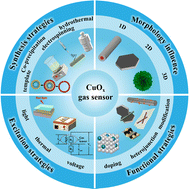Copper-based metal oxides for chemiresistive gas sensors
Abstract
In recent years, chemiresistive gas sensors with copper (Cu)-based metal oxides as sensitive materials have been widely investigated due to their merits of environmental friendliness, low cost, and nice compatibility with existing fabrication technologies. However, the comprehensive performance of Cu-based metal oxide gas sensors reported in previous studies may not be able to meet the requirements for practical applications in terms of sensing response, operating temperature, response/recovery speed, and selectivity. Therefore, functional strategies to improve their gas-sensing performance should be explored. Numerous investigations have indicated that the sensing performance can be enhanced by tuning the morphology, constructing heterojunctions, surface modification, doping, and other excitation strategies, such as thermal, light, and electrical strategies. In this review, the fundamental mechanisms of Cu-based metal oxide sensors are briefly described. Then, various synthesis technologies and the influence of morphologies on their sensing performance are discussed. After that, surface engineering (constructing heterojunctions with other metal oxides and 2D layered nanomaterials and modification with noble metals) and doping engineering (element doping) are summarized in detail. Additionally, the other excitation strategies to improve the sensing properties are also highlighted. Finally, the challenges and prospects of Cu-based metal oxide gas sensors are proposed for the future research.



 Please wait while we load your content...
Please wait while we load your content...